Nvidia’s Blackwell rollout continues with GeForce RTX 5060 Ti, a direct replacement for RTX 4060 Ti in the midrange segment. Touting lower costs and architectural improvements, the new graphics card wastes no time in offering generational perks from the get-go, but just how much value does it offer compared to its predecessor?
Arriving on the scene with 8GB and 16GB configurations and access to Nvidia’s latest suite of enhancements via DLSS 4, there’s a lot to dig into, so let’s get right to it.
Specs
Blackwell’s GB206 GPU serves as the brains behind RTX 5060 Ti, built using the same TSMC 4N process as Lovelace but trimmed and tuned for efficiency. Die size has marginally shrunk from 188mm² to 181mm², with a slight transistor count drop (21.9bn vs. 22.9bn) to match. It’s a leaner design on paper but delivers more where it matters.
| RTX 5060 Ti | RTX 4060 Ti | Ratio | |
|---|---|---|---|
| Released | Apr 2025 | May 2023 | – |
| Codename | Blackwell | Lovelace | – |
| GPU | GB206 | AD106 | – |
| Process | TSMC 4N (4nm) | TSMC 4N (4nm) | – |
| Transistors | 21.9bn | 22.9bn | 0.96 |
| Die size | 181mm² | 188mm² | 0.96 |
| CUDA cores | 4,608 | 4,352 | 1.06 |
| Boost clock | 2.57GHz | 2.54GHz | 1.01 |
| FP32 Boost TFLOPS | 24 | 22 | 1.09 |
| SM count | 36 of 36 | 34 of 36 | 1.06 |
| RT cores | 36 (4th Gen) | 34 (3rd Gen) | 1.06 |
| RT TFLOPS | 72 | 51 | 1.41 |
| Tensor cores | 144 (5th Gen) | 136 (4th Gen) | 1.06 |
| ROPs | 48 | 48 | 1.00 |
| Memory | 16GB / 8GB | 16GB / 8GB | 1.00 / 1.00 |
| Memory type | GDDR7 | GDDR6 | – |
| Memory clock | 28Gb/s | 18Gb/s | 1.56 |
| Memory interface | 128-bit (PCIe 5.0 x8) | 128-bit PCIe 4.0 x8) | 1.00 |
| Memory bandwidth | 448GB/s | 288GB/s | 1.56 |
| Board power | 180W | 160W | 1.13 |
| Launch MSRP | $379 / $429 | $399 / $499 | 0.95 / 0.86 |
Core counts across the board, CUDA, RT, and Tensor, rise by 6% across generations. Boost clock frequency also receives a minor nudge to 2.57GHz, while theoretical FP32 throughput increases to 24 TFLOPS – roughly 9% more than RTX 4060 Ti. While these figures might not scream next-gen, architectural enhancements paint a different picture.
Ray tracing performance benefits from the leap to fourth-gen RT cores, pushing RT TFLOPS to 72 – a massive 41% increase over the 4060 Ti’s 51. This, paired with fifth-gen Tensor cores (144 in total), opens the door to significantly improved AI-assisted rendering and upscaling, particularly with DLSS 4 in play.
Memory remains at either 8GB or 16GB depending on the SKU, but bandwidth gets a major boost thanks to a switch to GDDR7 modules operating at 28Gb/s. With the 128-bit bus intact, memory bandwidth climbs to 448GB/s, a 56% increase compared to the 4060 Ti. PCIe connectivity also steps up to Gen 5, although the interface width remains limited to x8, just like before.
Despite the jump in performance, board power only rises modestly to 180W. That’s 20W higher than RTX 4060 Ti, but efficiency gains from Blackwell’s architecture keep thermals and acoustics in check.
On the pricing front, Nvidia has softened the blow compared to other Blackwell offerings. RTX 5060 Ti launches at $379 for the 8GB variant and $429 for the 16GB model, undercutting 4060 Ti’s launch MSRPs of $399 and $499 respectively. It’s a welcome change, though availability and partner markups may tell a different story at retail.
Performance
As always, we’ve tested RTX 5060 Ti 16GB and its 8GB predecessor on the same Club386 Ryzen 9 7950X3D test bench under fresh drivers and Windows 11 24H2. Both cards were benchmarked across a suite of modern titles and synthetic workloads at FHD (1080p) and QHD (1440p) resolutions to eliminate system-side discrepancies.

Our 7950X3D Test PCs
Club386 carefully chooses each component in a test bench to best suit the review at hand. When you view our benchmarks, you’re not just getting an opinion, but the results of rigorous testing carried out using hardware we trust.
Shop Club386 test platform components:
CPU: AMD Ryzen 9 7950X3D
Motherboard: MSI MEG X670E ACE
Cooler: Arctic Liquid Freezer III 420 A-RGB
Memory: 64GB Kingston Fury Beast DDR5
Storage: 2TB WD_Black SN850X NVMe SSD
PSU: be quiet! Dark Power Pro 13 1,300W
Chassis: Fractal Design Torrent Grey
While RTX 4060 Ti continues to hold its own at 1080p and dabbles in QHD with reasonable success using its lower memory buffer, doubling the VRAM helps RTX 5060 Ti pushes those boundaries further. The bandwidth improvements alone make it a far more comofrtable option for texture-heavy titles at 1440p, and DLSS 4 extends its reach even further. As for UHD, it’s not entirely off the table but less than ideal for both graphics cards.
Apps & AI
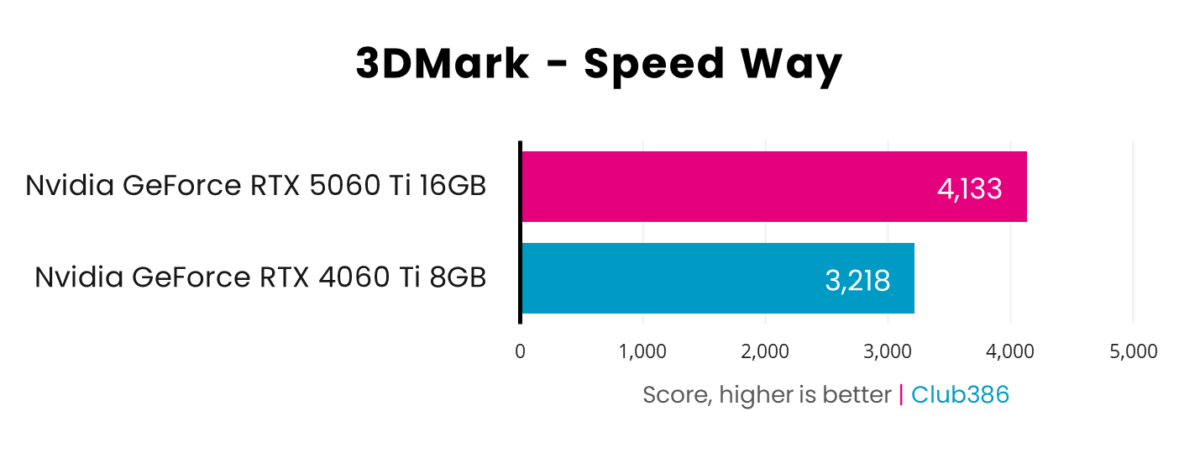
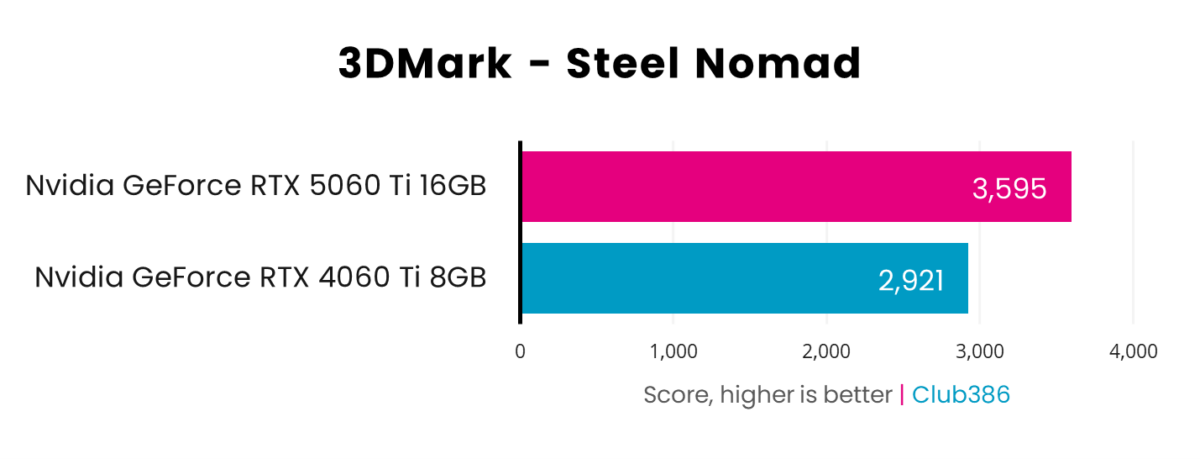
RTX 5060 Ti quickly establishes itself as a class above RTX 4060 Ti through its 3DMark performance. The two cards’ Steel Nomad scores illustrate a 23% difference in rasterised rendering capabilities in favour of the newcomer. However, switching to ray tracing in Speed Way creates even greater distance between them at 28%.
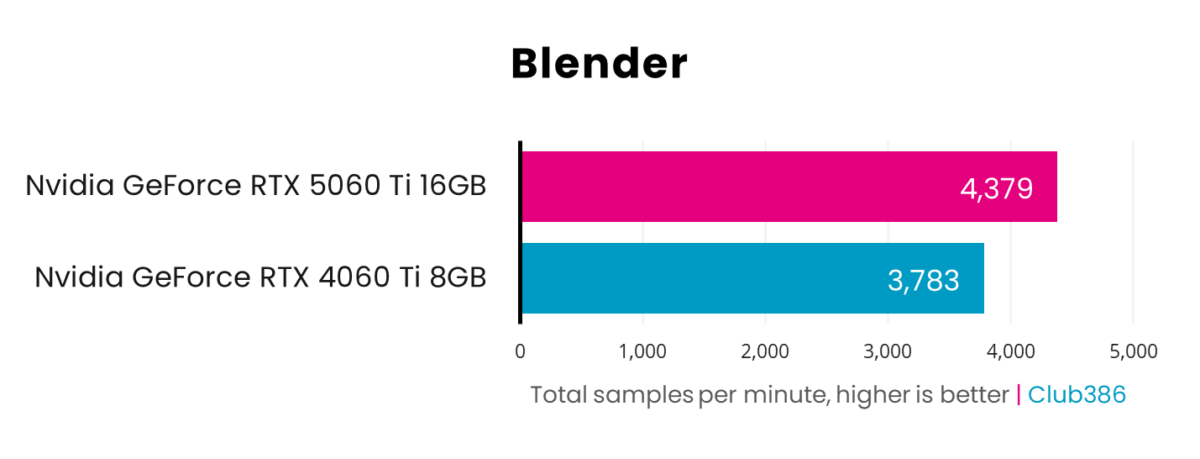
All the generational improvements to its specifications serve RTX 5060 Ti well in the realms of 3D rendering. Together, they net it a 16% uplift in total samples per minute versus RTX 4060 Ti.
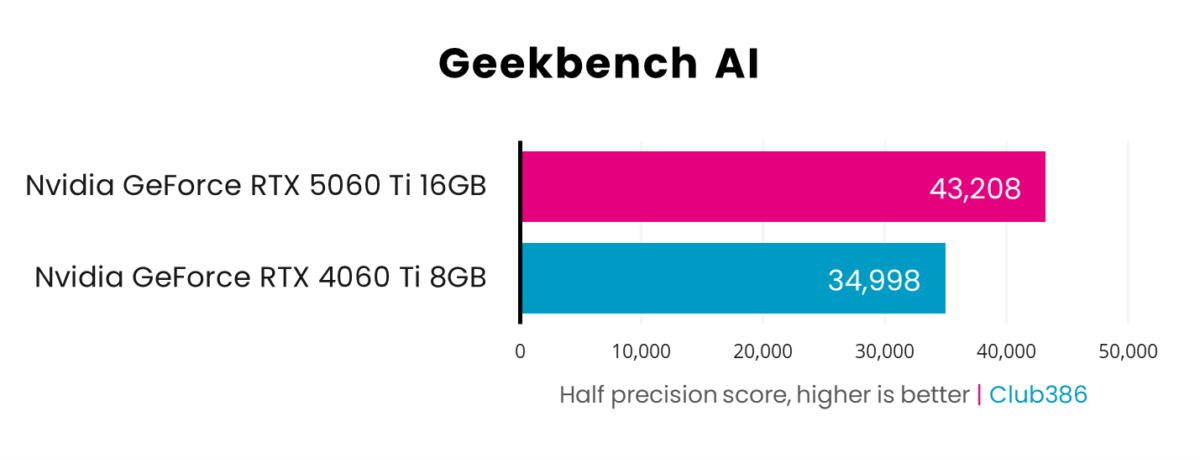
Generational increases in performance extend to FP16 handling too, as RTX 5060 Ti’s fifth-generation Tensor cores demonstrate their power. Their higher quantity and quantity relative to those found in RTX 4060 Ti see half precision scores increase by a welcome 23% in Geekbench AI.

In addition to its superior Tensor cores, it’s clear that RTX 5060 Ti’s higher bandwidth and buffer enhance its ability to run LLMs (Large Language Model) locally over RTX 4060 Ti. The end result is an impressive 90% increase in Llama 3.1 score in Procyon AI Text Generation.
Gaming
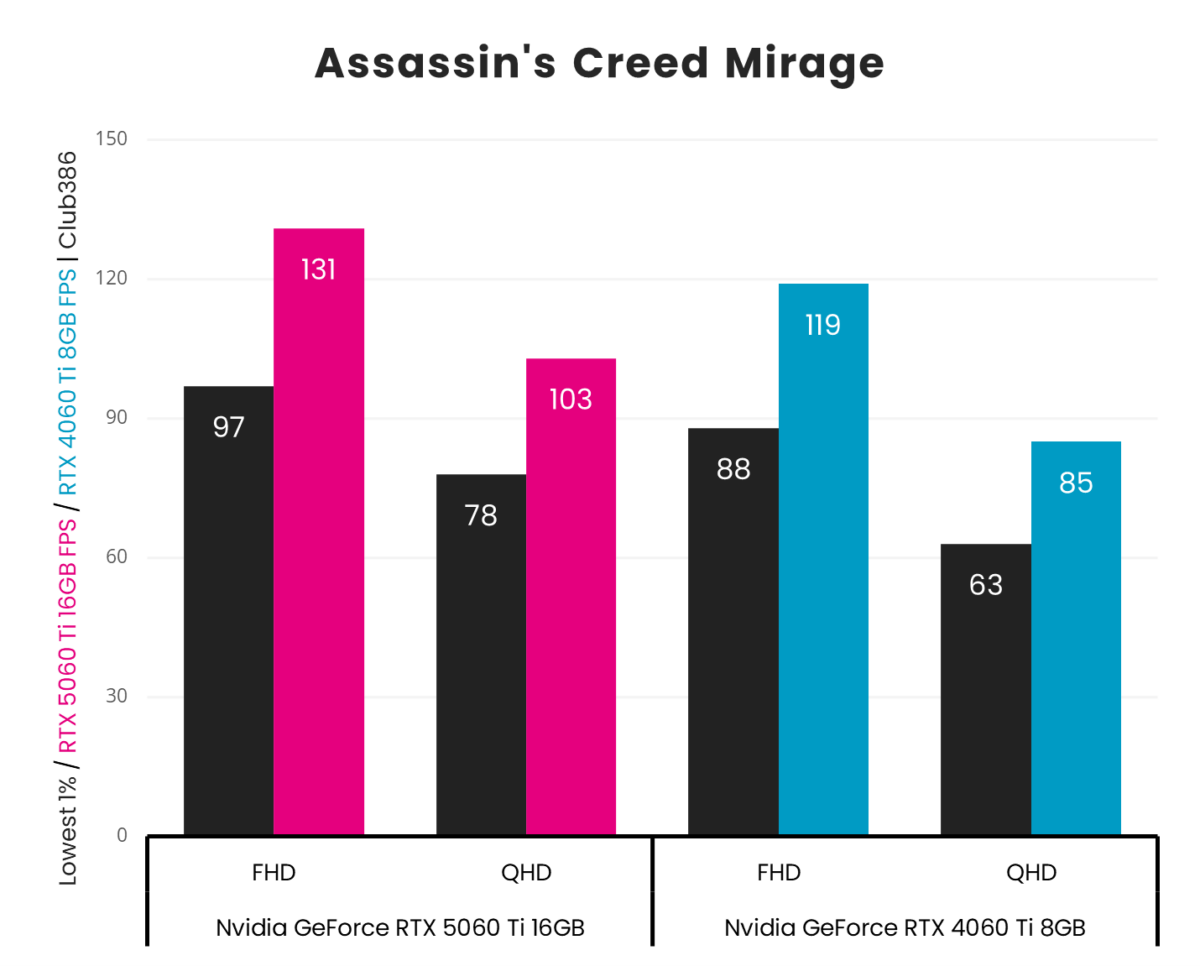
Running Assassin’s Creed Mirage on both cards at FHD paints RTX 5060 Ti in an underwhelming light as it offers up a mere 10% bump over RTX 4060 Ti in average frame rates. Switching to QHD, though, better separates the proverbial wheat from the chaff as a 21% difference emerges, with 1% lows improving further still at 40%.
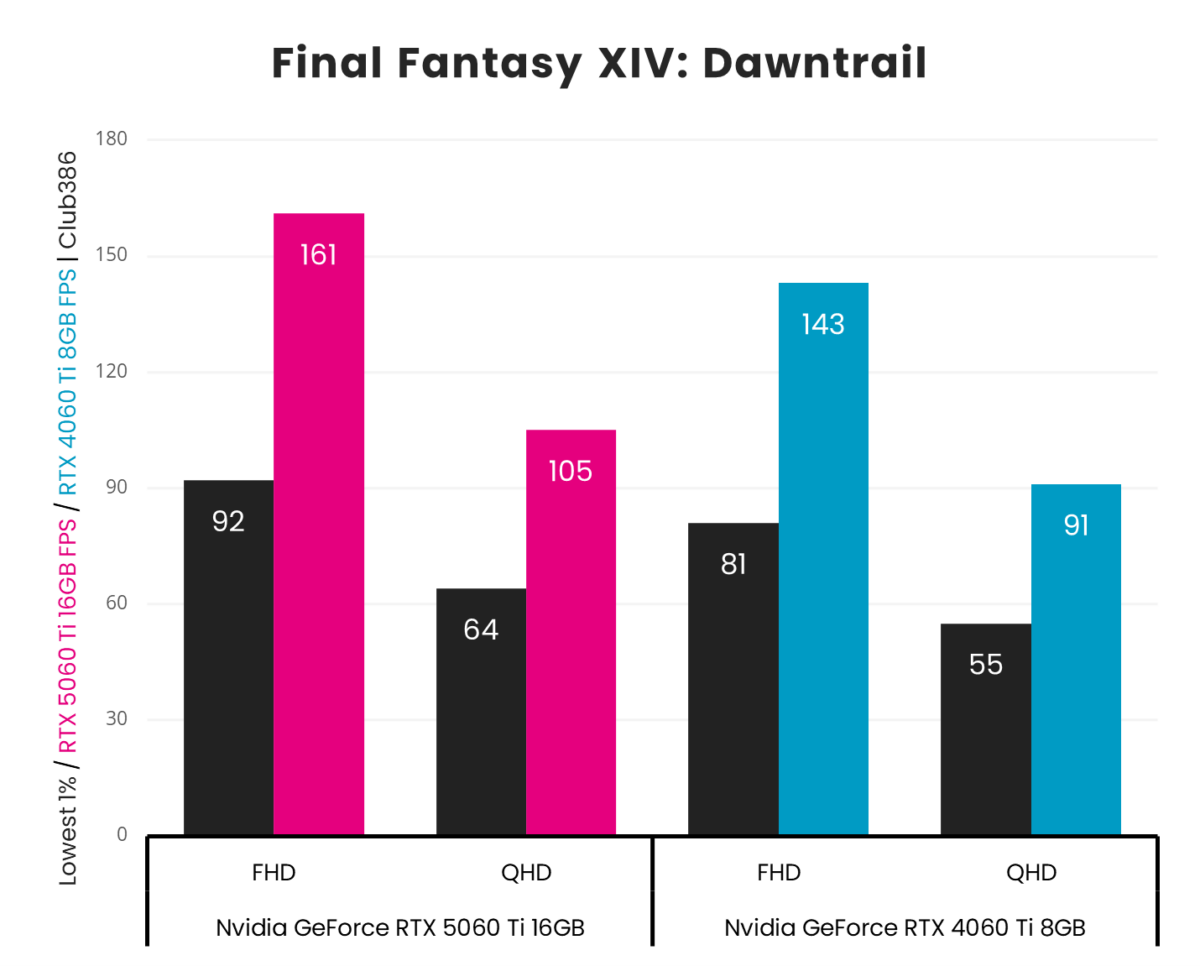
Final Fantasy XIV: Dawntrail serves as an example of how variable the generational uplift between RTX 5060 Ti and RTX 4060 Ti can be. Across resolutions, there’s an uninspiring 13-15% improvement in average frame rates.
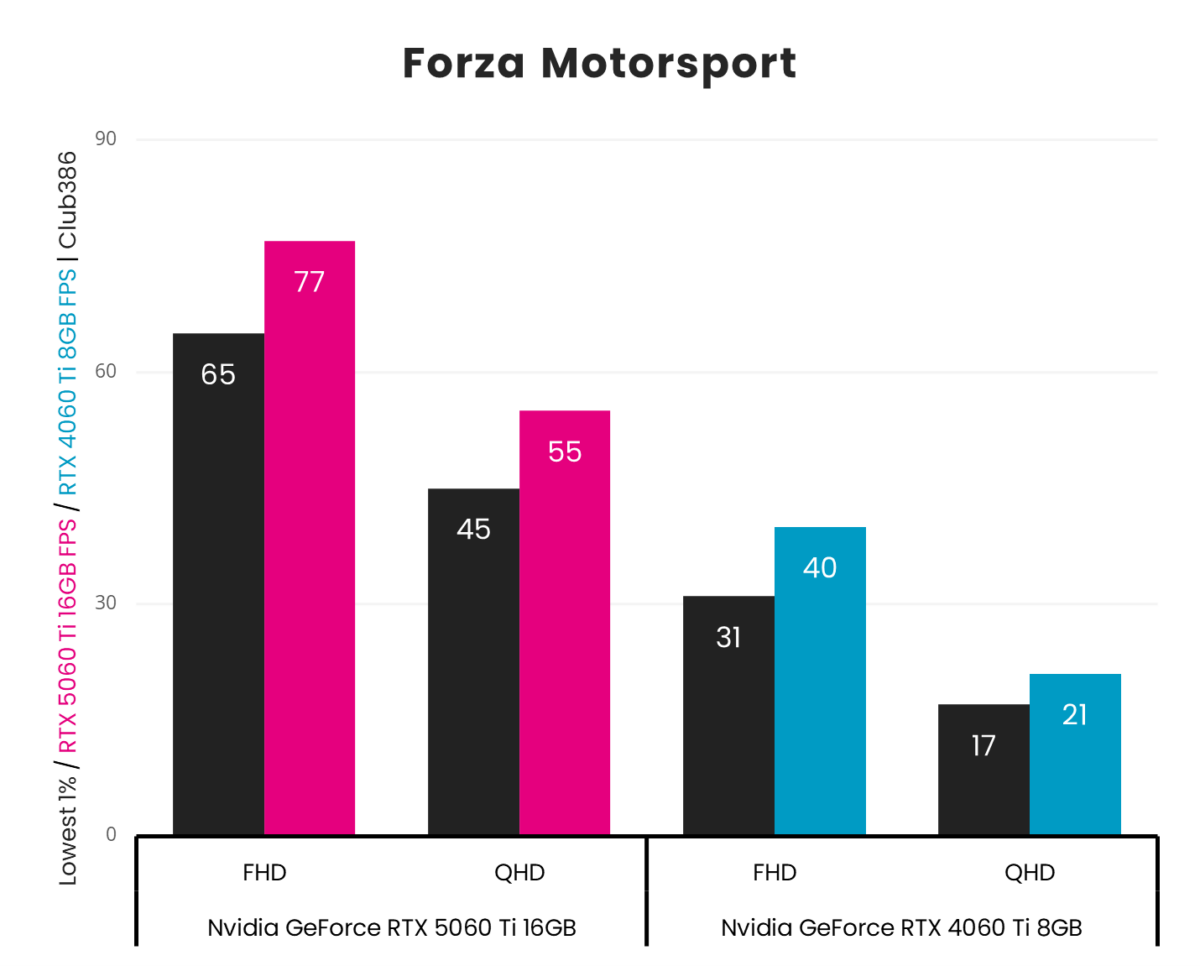
RTX 5060 Ti is lightyears ahead of RTX 4060 Ti in Forza Motorsport, to the tune of 93% at FHD and an enormous 162% at QHD.
Much as RTX 5060 Ti’s faster RT cores are responsible for this uplift, it also highlights the importance of memory bandwidth and capacity. Ray tracing effects places additional strain on VRAM, which RTX 4060 Ti 8GB simply doesn’t have enough of to keep up.
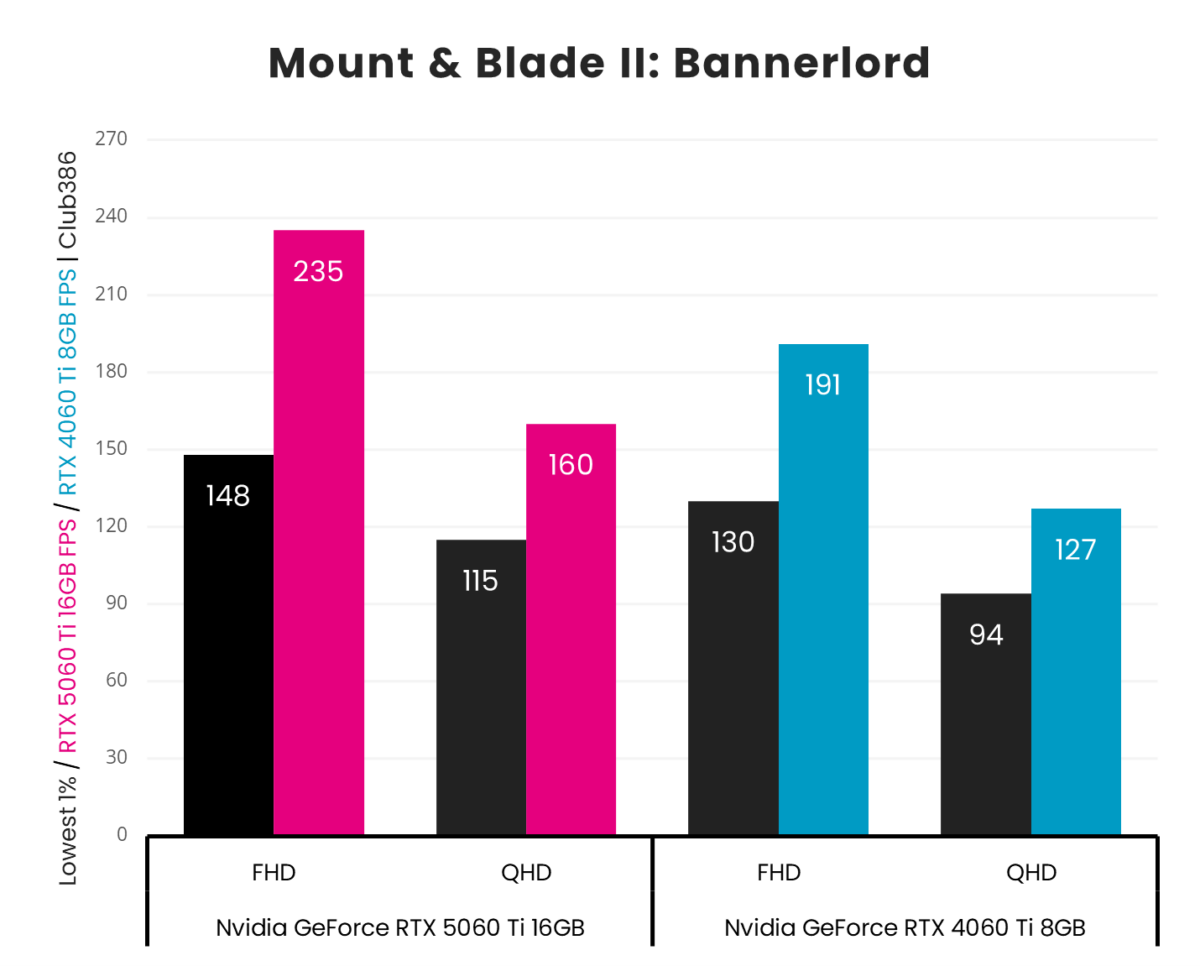
Swapping back to rasterised rendering, RTX 5060 Ti claims another clear victory over RTX 4060 Ti in Mount & Blade II: Bannerlord. It strikes decisively at FHD with a 23% lead but pushes its advantage at QHD with a 26% uplift in frame rate.
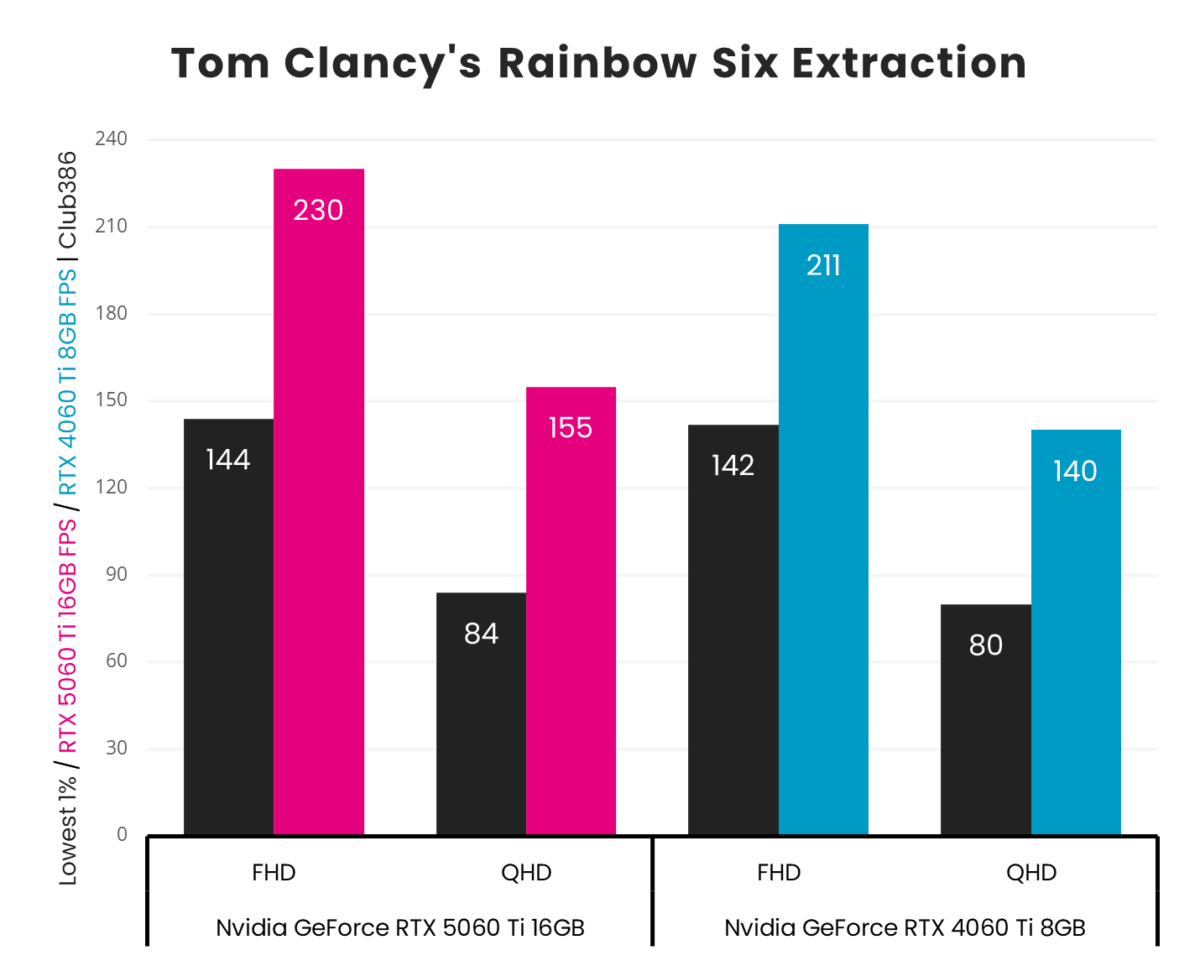
Both RTX 5060 Ti and RTX 4060 Ti deliver a high frame rate experience in Rainbow Six: Extraction across FHD and QHD. However, every frame counts in competitive shooters and the Blackwell card ultimately comes out on top in this respect, albeit mildly with a 9-11% generational performance bump.
DLSS
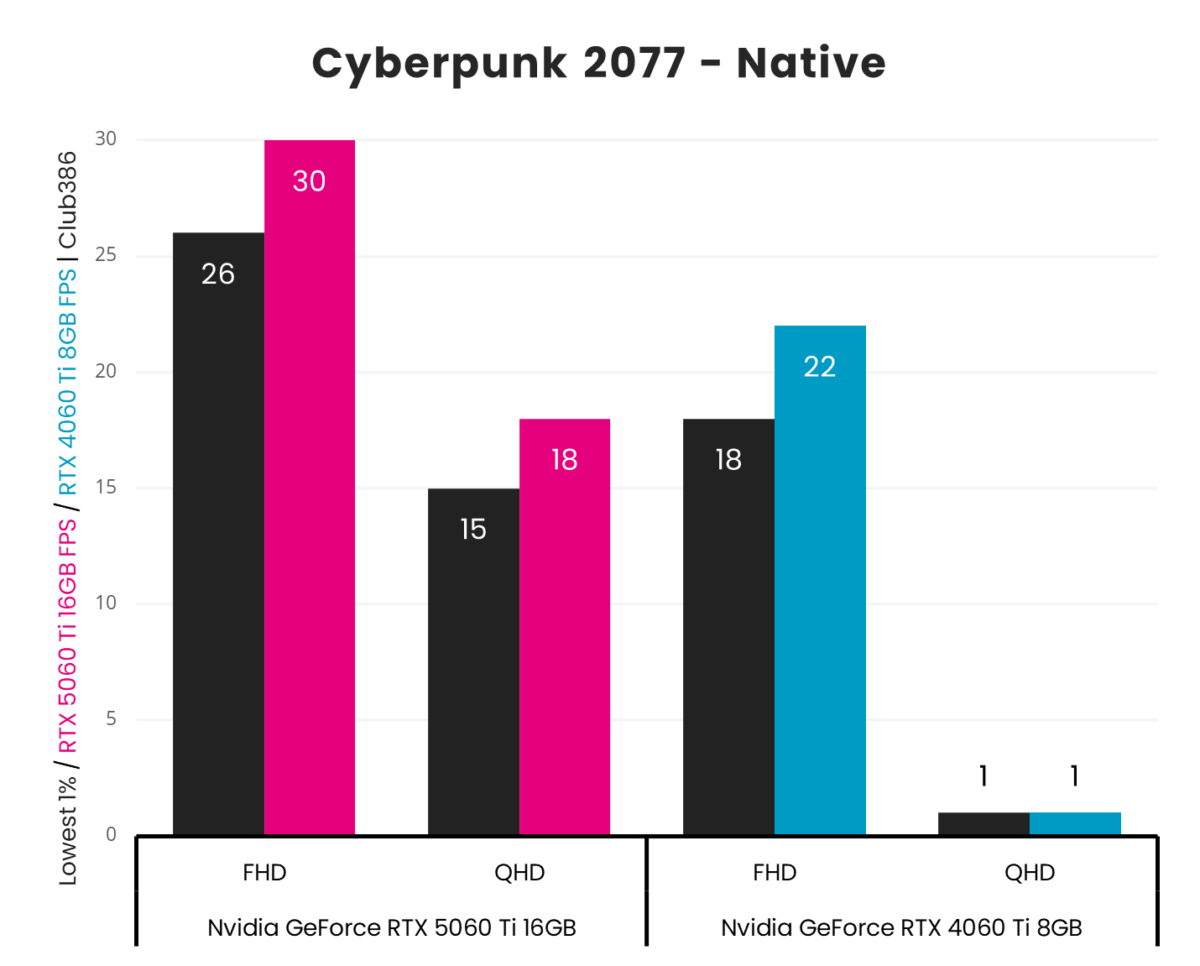
RTX 5060 Ti does a modest job of running Cyberpunk 2077 at FHD using the game’s path tracing preset, hitting an an acceptable 30fps on average. Of course, the only way from here is down as resolution goes up and the RPG becomes unplayable at QHD.
Meanwhile, RTX 4060 Ti can’t handle the pressure at FHD and absolutely crumbles at QHD with single-digit frame rates at the latter resolution.
Now we know how each card performs natively, it’s time to turn to DLSS Super Resolution and Frame Generation for assistance.
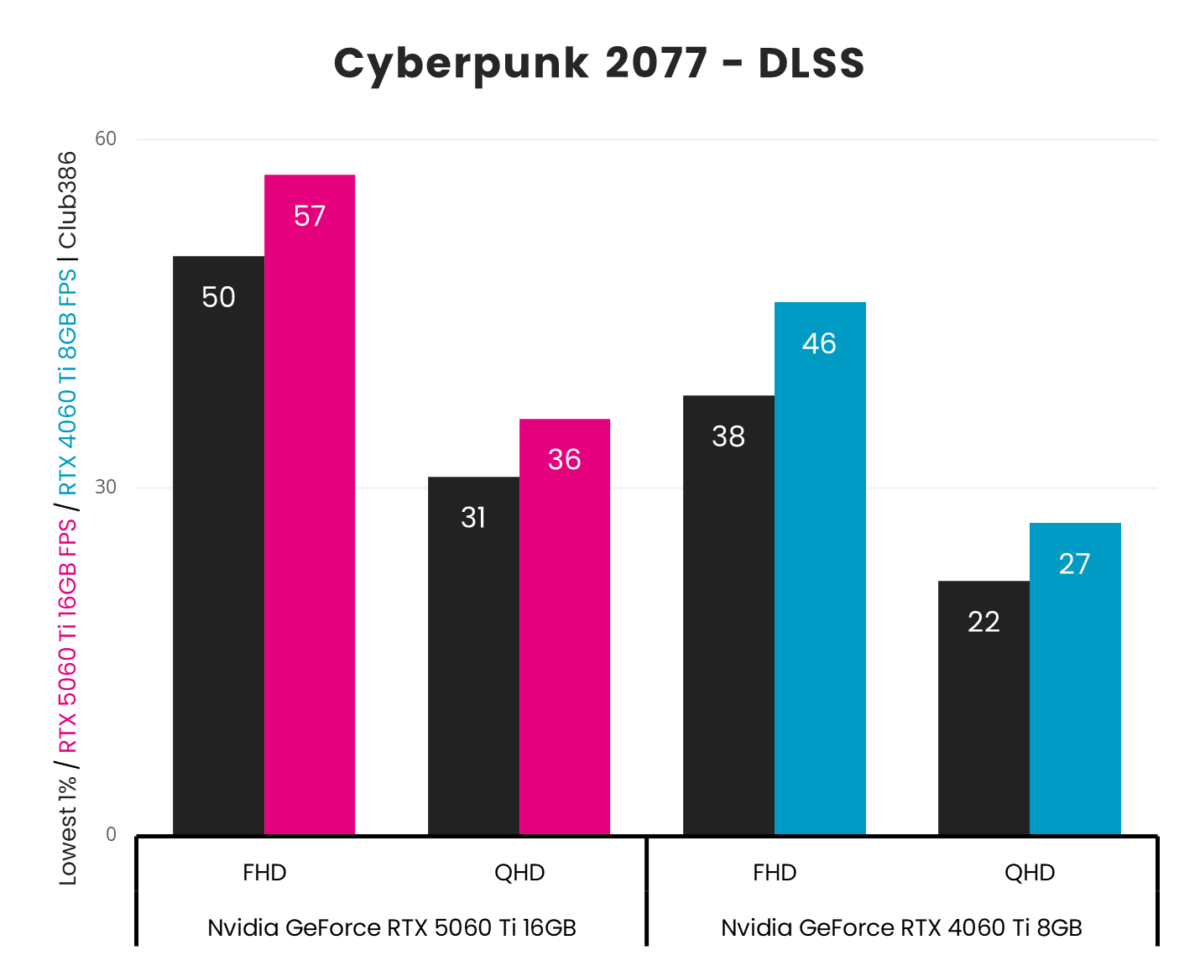
Switching on DLSS Super Resolution, RTX 5060 Ti doubles its QHD frame rates from 18fps to 36fps, transforming a formerly unplayable experience to a functional one. Upscaling has a similarly revitalising effect at FHD, pushing average frame rates up from a scraped 30fps to a comfortable 57fps.
RTX 4060 Ti no longer resembles a slideshow at QHD but DLSS Super Resolution unfortunately can’t help it hit that all-important 30fps threshold. Thankfully, the card now offers a playable experience at FHD but trails its successor by 24% at the same resolution.
- It’s worth nothing that RTX 5060 Ti can run Nvidia’s higher-quality Transformer model for upscaling with minimal impact to performance. RTX 4060 Ti does support it but turning it on will have a more obvious negative effect on frame rate compared to the Convolutional alternative.
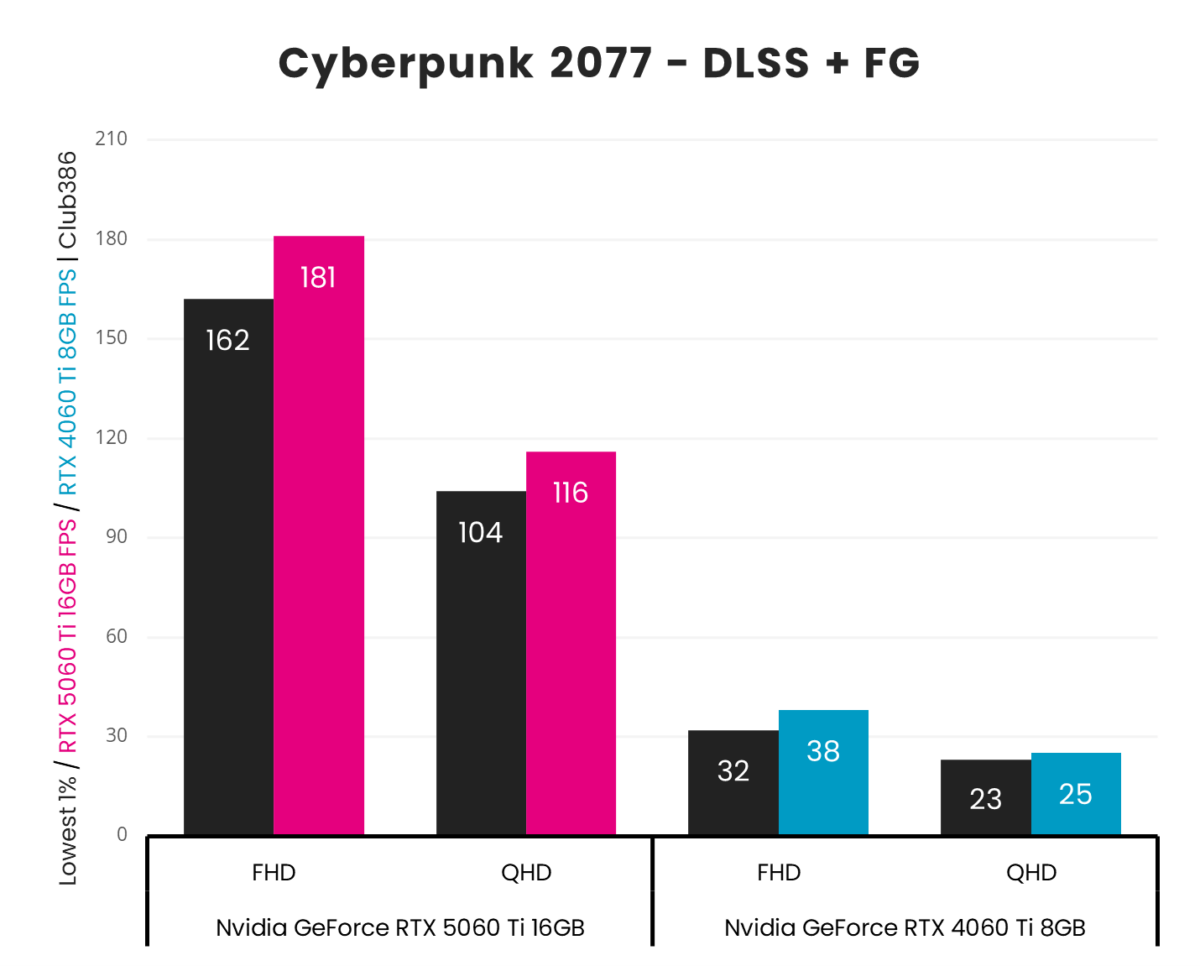
Working in tandem with Super Resolution, DLSS Frame Generation proves a blessing for RTX 5060 Ti but a curse for RTX 4060 Ti. This isn’t a fault of the feature and is instead a knock-on effect of the latter card’s paltry bandwidth which reaches breaking point. As a result, frame rates tumble.
In all fairness, RTX 4060 Ti didn’t provide enough performance out of the gate to warrant using frame generation. RTX 5060 Ti doesn’t either at QHD but its 57fps base frame rate at FHD provides a healthy foundation for DLSS 4 to work its magic.
Vitals
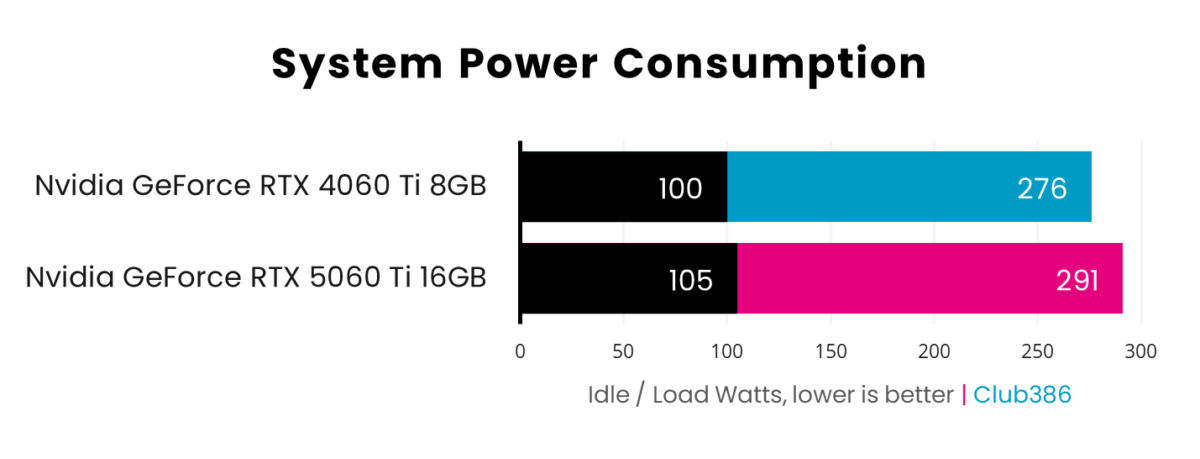
Despite its 180W TBP being 13% higher than its predecessor, RTX 5060 Ti only pushes system power consumption in the Club386 test bench up by 5% compared to 4060 Ti in my tests. While I’d prefer to see the amount of watts coming from the wall go down gen-on-gen, it’s ultimately easy to forgive considering how much more the new card is able to do with them.

RTX 5060 Ti clinches the win in terms of operating temperatures, by a single degree. For clarity, this is a comparison between a triple-fan Asus Prime OC cooler while RTX 4060 Ti rocks a Palit Dual OC design.
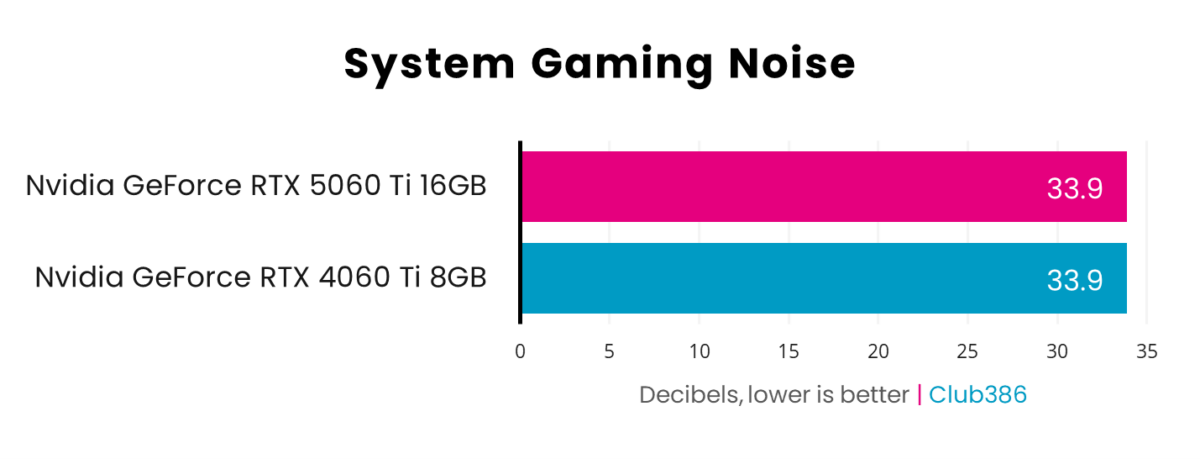
Like temperatures, noise profiles will vary depending on the cooler in question as there’s no reference design Founders Edition model to create a baseline. Still, comparing Asus Prime OC RTX 5060 Ti to Palit Dual OC RTX 4060 Ti, the cards are indistinguishable to the ear.
Conclusion
RTX 5060 Ti might not deliver headline-grabbing frame rates like its higher-tier siblings, but it corrects many of the criticisms aimed at RTX 4060 Ti – namely, its limited memory bandwidth and awkward pricing. Blackwell brings refinement, and in this segment, refinement makes all the difference.
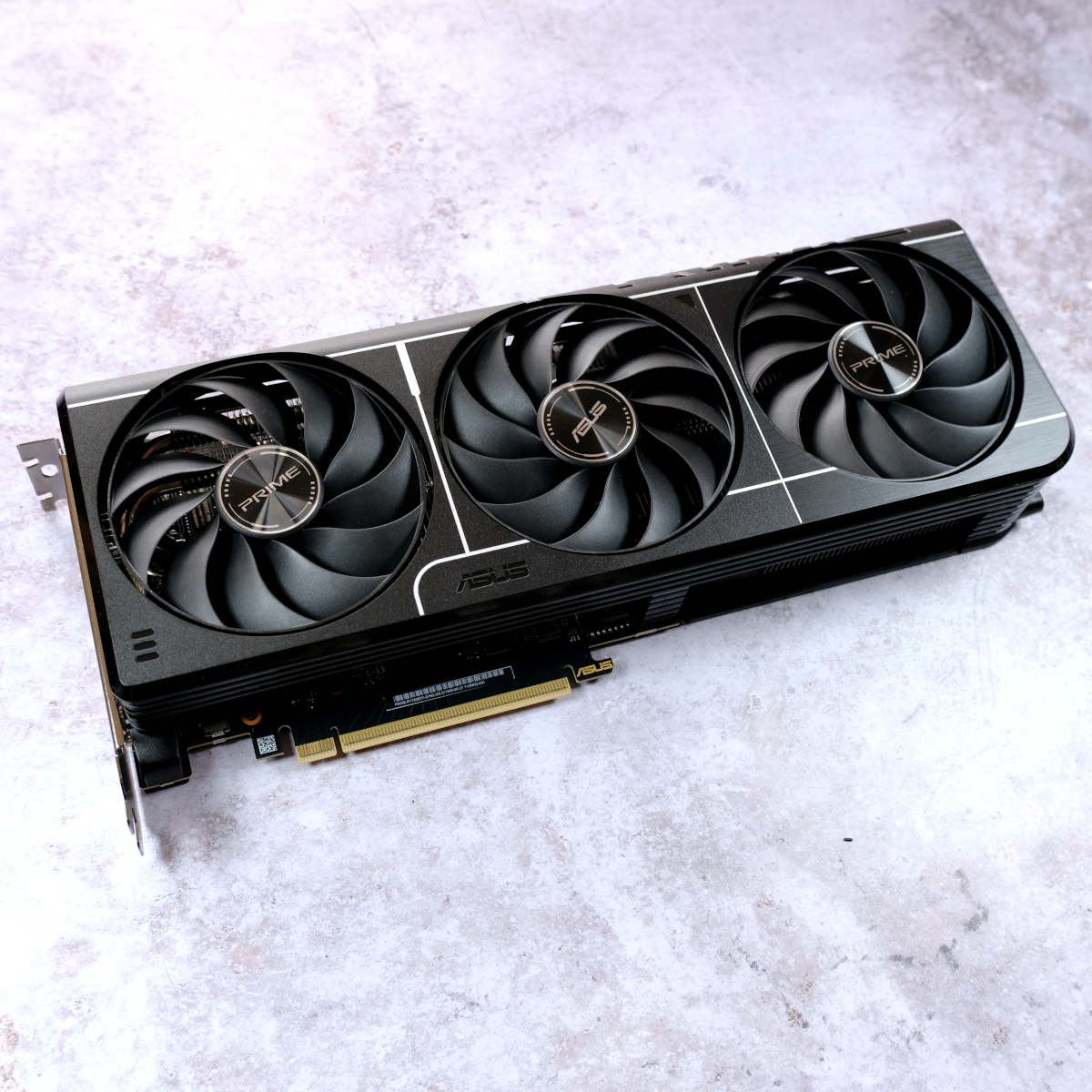
GeForce RTX 5060 Ti
“GeForce RTX 5060 Ti 16GB brings the power of Blackwell to the mainstream with solid results.” Read our review.
If you’re rocking an RTX 4060 Ti 8GB, there’s certainly cause to upgrade to RTX 5060 Ti 16GB to free yourself from the constraints of its bandwidth and buffer. I’d ignore RTX 5060 Ti 8GB altogether, despite its lower price tag, as you’ll run into the same VRAM capacity issues you’re already experiencing.


